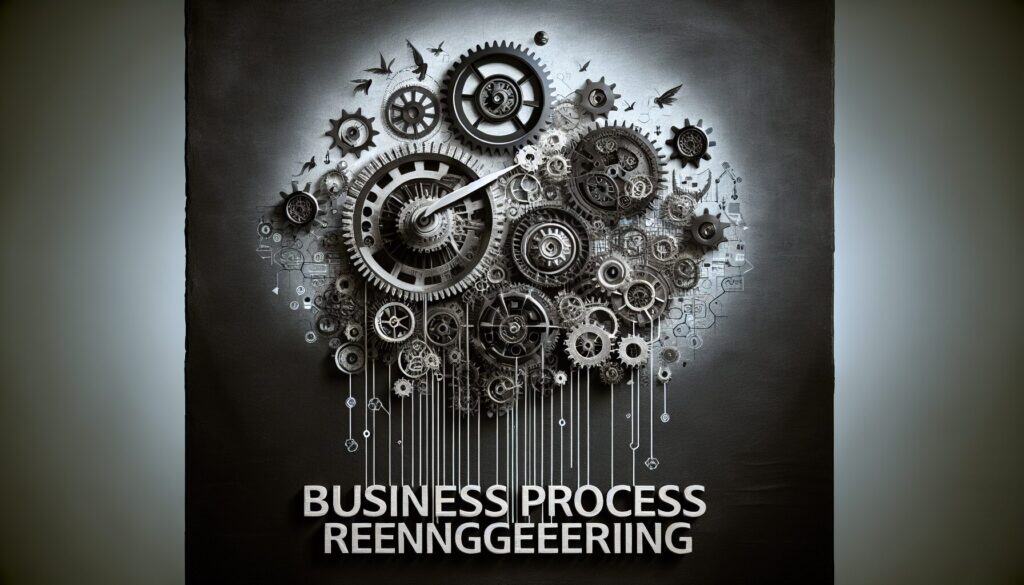Approche de gestion visant à redéfinir radicalement les processus de base des entreprises afin d'obtenir des améliorations spectaculaires en termes de productivité, de durée des cycles et de qualité.
- Méthodologies : Ergonomie
Réingénierie du marteau et du champignon (Business Process Reengineering - BPR)

Réingénierie du marteau et du champignon (Business Process Reengineering - BPR)
- Business Process Reengineering (BPR), Gestion du changement, Amélioration continue, Innovation, Production allégée, Amélioration des processus, Optimisation des processus, Gestion de la qualité, Cartographie de la chaîne de valeur
Objectif :
Comment il est utilisé :
- Il s'agit de repenser fondamentalement et de redéfinir la manière dont le travail est effectué, souvent en s'appuyant sur les technologies de l'information, afin de réaliser des percées en matière de performances plutôt que des améliorations progressives.
Avantages
- Peut conduire à des améliorations significatives en termes d'efficacité, de réduction des coûts et de satisfaction de la clientèle ; encourage l'innovation radicale et remet en question les hypothèses existantes.
Inconvénients
- Risque élevé d'échec ; peut perturber l'organisation et le moral des employés ; nécessite un leadership fort de la part de la direction et un investissement important ; implique souvent des suppressions d'emplois.
Catégories :
- Gestion de projet, Qualité
Idéal pour :
- Améliorer radicalement les performances des entreprises en repensant fondamentalement leurs processus de base.
La méthodologie de réingénierie des processus métier (BPR) de Hammer et Champy est particulièrement pertinente dans les industries en cours de transformation numérique, telles que l'industrie manufacturière, les soins de santé et la vente au détail. Elle est généralement appliquée pendant les phases de projet qui impliquent des changements substantiels dans les flux de travail ou l'intégration de nouvelles technologies. Les organisations lancent souvent le BPR lorsqu'elles cherchent à remédier à la baisse des mesures de performance ou à l'escalade des coûts opérationnels, ce qui nécessite généralement la participation d'équipes interfonctionnelles comprenant des parties prenantes de divers départements tels que l'informatique, les finances et les opérations, afin de garantir une approche globale. Par exemple, une entreprise manufacturière peut mettre en œuvre la BPR pour remanier ses processus de chaîne d'approvisionnement en tirant parti de l'analyse de données avancées pour une meilleure gestion des stocks, ce qui permet de prendre des décisions en temps réel et d'améliorer les calendriers de production. De telles initiatives encouragent les équipes à remettre en question les pratiques existantes et à supprimer les étapes inutiles, ce qui favorise l'innovation. Des efforts de réingénierie réussis peuvent se traduire non seulement par une efficacité accrue, mais aussi par une transformation de la manière dont les entreprises s'engagent avec leurs clients, ce qui conduit en fin de compte à des niveaux de satisfaction plus élevés, les services devenant plus rapides et plus fiables. Les entreprises qui ont mis en œuvre cette approche font souvent état non seulement de gains financiers, mais aussi d'une évolution culturelle vers l'acceptation du changement et de l'amélioration continue au sein du personnel. La nature collaborative du BPR favorise le partage des connaissances entre les employés, ce qui crée un environnement propice à l'émergence de solutions innovantes pour résoudre les problèmes opérationnels les plus urgents.
Principales étapes de cette méthodologie
- Identifier les processus existants qui doivent être réorganisés.
- Analyser et remettre en question les hypothèses qui sous-tendent les processus actuels.
- Définir les objectifs et les buts des processus remaniés.
- Développer de nouvelles conceptions de processus qui tirent parti de la technologie et de l'innovation.
- Mettre en œuvre les processus remaniés dans l'ensemble de l'organisation.
- Mesurer la performance des nouveaux processus par rapport aux objectifs fixés.
- Affiner et améliorer en permanence les processus sur la base du retour d'information et des données de performance.
Conseils de pro
- Procéder à une analyse approfondie des processus existants afin de découvrir les inefficacités et les redondances cachées avant d'entamer des efforts de refonte.
- Incorporer des équipes interfonctionnelles dans le processus de réingénierie afin de garantir la diversité des points de vue et des compétences.
- Mettre en œuvre une approche progressive pour l'intégration des technologies afin de permettre un retour d'information itératif et de minimiser les perturbations pendant la transition.
Lire et comparer plusieurs méthodologies, nous recommandons le
> Référentiel méthodologique étendu <
ainsi que plus de 400 autres méthodologies.
Vos commentaires sur cette méthodologie ou des informations supplémentaires sont les bienvenus sur le site web de la Commission européenne. section des commentaires ci-dessous ↓ , ainsi que toute idée ou lien en rapport avec l'ingénierie.
Contexte historique
1960
1980
1983
1990
1995
2000
2010
1950
1980
1980
1986
1994
1995
2000
(si la date est inconnue ou n'est pas pertinente, par exemple "mécanique des fluides", une estimation arrondie de son émergence notable est fournie)














Articles Similaires
Gestion des opérations de fabrication (MOM)
Système d'exécution de la fabrication (MES)
Plan de contrôle de la fabrication
Tests manuels
Tableaux d'évaluation des manutentions manuelles (MAC)
ManTRA (outil d'évaluation des risques liés aux tâches manuelles)